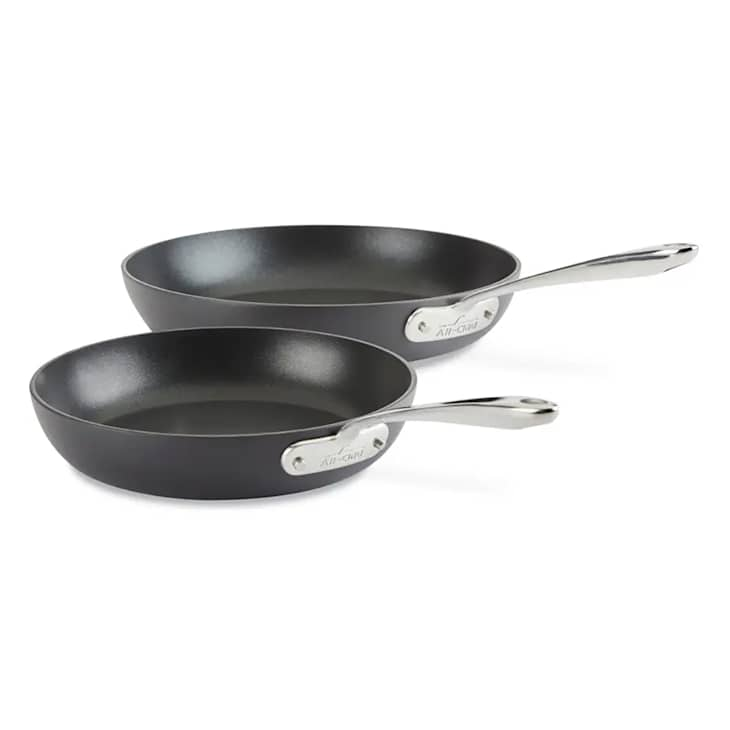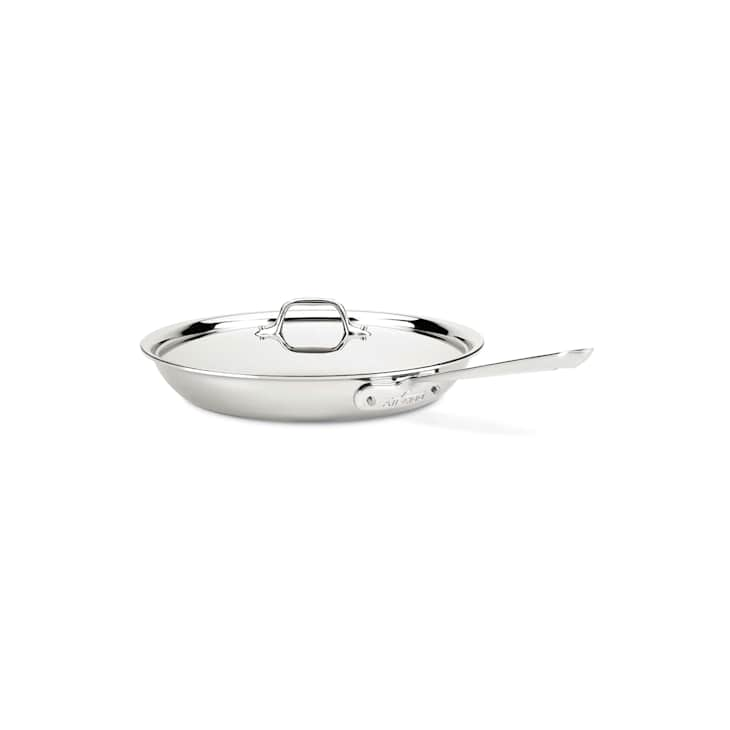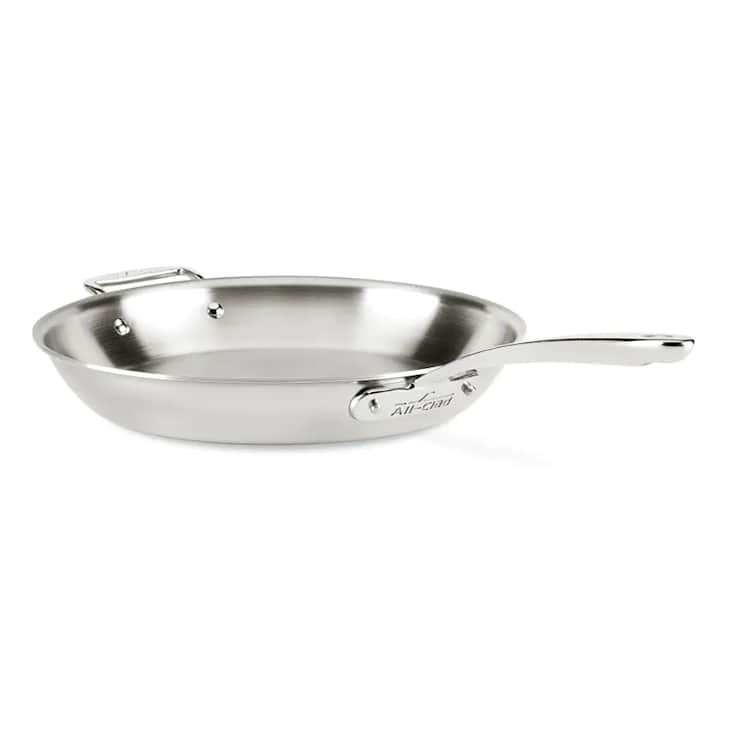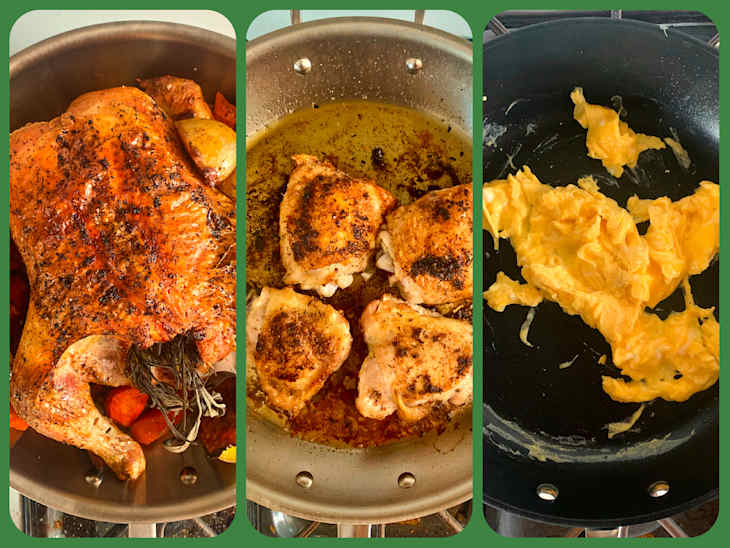

The search for a great skillet can seem overwhelming. There are many options out there to choose from. If you’re looking for a workhorse that can sear as well as it sautés, and will last you for years to come, look no further than All-Clad. All-Clad has been making some of the best skillets on the market for over 50 years. But even in the specific world of All-Clad, there’s still a lot to choose from. I was in search of the perfect All-Clad skillet, so I put four models to the test.
What Is All-Clad?
All-Clad is a storied cookware brand that’s been around since the 1970s. They are based in Canonsburg, Pennsylvania, and are known for their high-quality stainless steel cookware. In addition to stainless steel they produce nonstick and cast iron cookware, knives, bakeware, small appliances, and a variety of other kitchen and outdoor cooking equipment.
All-Clad has a well-earned reputation for being durable and well-made; it lasts for many years in the kitchens of countless home cooks. Founded by a metallurgist who applied his extensive knowledge to cookware, it’s well-known for superior construction and even heating.

How We Tested All-Clad Skillets
All-Clad has many different product lines made with different materials and boasting different features. For this review we focused on skillets and specifically tested 12-inch (and, in one case, 12.5-inch) models. I used all four of the pans in my kitchen for over a month, doing everything from cooking pasta dishes to searing steak to sautéing bacon in them. In addition to everyday cooking tasks, I put each skillet through specific tests: searing bone-in skin-on chicken thighs on the stovetop and finishing them in the oven, and cooking eggs in each one. I also washed each one by hand after every test to get a sense of how easy (or difficult) they are to clean.
Essentials Hard Anodized Nonstick Skillet
What’s so great
- High, rounded sides make tossing and stirring easy
- Comfortable handle
- Even cooking
- Truly nonstick cooking surface
- Very easy to clean
Good to know
- Not induction compatible (for induction-compatible nonstick, try the HA1 line)
- Sold in a set of two (10-inch and 12-inch)
Aluminum sits in the middle of every pan we tested. It’s lightweight, inexpensive, and a great heat conductor. In the case of the Essentials Hard Anodized Cookware line, an aluminum core is dipped in a chemical bath with an electrical current running through it (i.e., the “hard anodizing” process), which makes the surface much more durable and prevents it from reacting with acidic ingredients. The pan is then coated with three layers of PFOA-free nonstick coating, which makes it incredibly slick.
I really enjoyed cooking in this pan. I use a variety of different types of pans for day-to-day cooking depending on the dish I’m preparing. Despite my dearth of cookware options, the reality is that my nonstick pans get the most heavy use. You simply can’t beat the ease — both for cooking and cleanup — of a good-quality nonstick skillet. This skillet excelled in my daily cooking tasks and performed very well in formal testing. The handle is very comfortable to hold; it’s closer in shape to the D3 Everyday line than the other skillets I tested. It feels secure — even when the pan is weighed down with heavy food.
I love the rounded high sides of this pan. It’s like a cross between a traditional skillet and a saucier, which makes tossing food easy. Eggs cooked up great in this pan; it’s very slippy and nothing sticks. I can’t speak to its performance over time, but over the course of a month’s worth of breakfasts it never let me down. I also seared steak (yes, you can sear steak in a nonstick pan) and cooked an entire package of bacon Snoop-style. The high, rounded sides made swirling the bacon around no problem, and I wasn’t worried about sloshing hot grease over the sides of the skillet.
I always feel weird putting nonstick in the oven — and by “feel weird about,” I mean I don’t do it. However, in the name of science I seared off some chicken thighs and finished them in the oven. I didn’t add any oil to the pan before searing, and let it preheat before adding the chicken, but cooked it over medium heat, per the manufacturer’s instructions. The chicken took just a touch longer (about 4 minutes instead of 2 or 3) to get nice browning, but I actually really liked that because it gave me more control. In some of the stainless skillets the browning happened faster than I was expecting and the chicken got a bit darker than I wanted. The nonstick allows me a bit more wiggle room to get that perfect golden hue I’m after. The chicken came out well-cooked and moist, in the same amount of overall cook time as the stainless pans once in the oven. At the end of testing I had very few complaints about this skillet, and it’s become my go-to nonstick.
Who It’s Best For: Anyone! Cooking in this pan is a breeze, with no hot-spots, even cooking, and easy cleanup; it can even go in the oven.
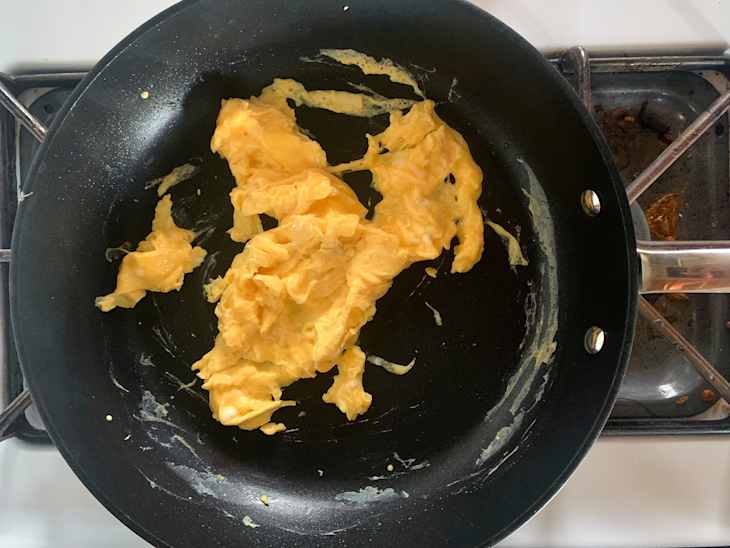
Specifications
- Material: Aluminum with stainless steel handle
- Layers: 4 (hard-anodized aluminum coated in 3 layers of PFOA free nonstick coating)
- Max Temp: 500°F
- Compatibility: Cook over low and medium heat; oven-safe to 500°F
- Sizes Available: 10-inch and 12-inch (sold as a set)
D3 Stainless Steel Skillet
What’s so great
- Even cooking
- Compatible with all stovetops (including induction)
- Comes with a lid
Good to know
- No opposite side handle
- Handle design is not as ergonomic as the D3 or Nonstick
D3 is All-Clad’s “entry level” line and, as it happens, the one I owned previously before embarking on this testing. My D3 skillet has served me well for years. Note that in order to keep the playing field even for this testing I used a brand-new skillet — not the one I already owned. The core of the skillet is aluminum sandwiched between layers of stainless steel. This three-ply construction is All-Clad’s original claim to fame, and it still holds up today.
This pan is a truly solid center point in the universe of stainless steel cookware. It’s not too heavy, which makes it easy to maneuver — even with food inside. It sears well and cooks food evenly with no hot spots. It can go in the oven and under the broiler. You can cook chicken in it and make a pan sauce after, scraping up the fond with whatever tool you like. As mentioned above, this pan has been my go-to stainless steel option for years.
The one thing I don’t love about it is that it heats up pretty quickly. When testing cooking chicken thighs, they browned up at a noticeably rapid rate when compared to other pans in my testing (2 /12 to 3 minutes per side, as opposed to the 5 minutes it took to get equal browning in the D5 pan). There were a few spots that were a bit darker than I wanted, but overall I don’t consider that a deal-breaker. Eggs stuck to the stainless steel surface of this pan, even with ample oil. I was able to release the eggs with the help of a spatula after a few minutes, but that meant they were a little more cooked than I would have liked. (In general, I think nonstick and cast iron are both better choices for egg cooking, but that’s another article entirely.)
Stainless steel is not too difficult to clean if you have the right products, and this pan is no exception. Use a little Bar Keeper’s Friend and give it a good scrub, and it looks like new no matter what you cooked in it.
Who It’s Best For: If you’re looking for a solid, no-frills start to your stainless steel cookware collection, this is a great option.

Specifications
- Material: Stainless steel
- Layers: 3 (aluminum core surrounded by stainless steel)
- Max Temp: 600°F
- Compatibility: Gas, electric, and induction ranges, oven-safe, broiler-safe
- Sizes Available: 7.5, 8, 10, 12, 14 inches
D3 Stainless Everyday Skillet, 12.5-Inch
What’s so great
- Even cooking
- Compatible with all stovetops (including induction)
- Comfortable, contoured handle
- Opposite side handle (not present on smaller-sized skillets)
Good to know
- Slightly more expensive than the classic D3 skillet
- Slightly larger (12.5 inches) than other pans we tested
The Everyday line is a newer addition to the All-Clad line up. It features the same three-ply construction as the classic D3 line and adds some key features like drip-free pouring rims, flared sides, and a more comfortable, contoured handle. This skillet is also slightly larger than the others I tested at 12.5-inches, which gives it over 30% more cooking surface area.
As someone who has been happily cooking in a D3 skillet for years, I was very interested to see how this upgraded version of the line performed. I was pleased to discover that every change was thoughtfully executed and did, in fact, improve my cooking experience. The contoured handle in particular is a big deal to me. The newer design is much more comfortable to hold — especially when the skillet is full of heavy food. Additionally, this skillet has an opposite-side handle, which gives you a place to hold the skillet securely on both sides (a big improvement!).
As with the classic D3 skillet (they share the same construction), chicken browned up well — but quickly — leading to a few darker spots than I wanted. Eggs stuck to the surface of the pan, but not a lot. I was able to get a spatula underneath a fried egg and flip it, but not without breaking the yolk. When it came time for cleaning up, it was a virtually identical experience to washing the classic D3. I employed a good cleaner and a bit of elbow grease, and the pan looked as good as new afterwards.
Who It’s Best For: Anyone who wants the reliable, even cooking of the D3 line, but is willing to pay a bit more for features that make it even better, like a contoured handle, opposite-side handle, and larger cooking surface.

Specifications
- Material: Stainless steel
- Layers: 3 (aluminum core surrounded by stainless steel)
- Max Temp: 600°F
- Compatibility: Gas, electric, and induction ranges, oven-safe, broiler-safe
- Sizes Available: 8.5, 10.5, 12.5 inches
D5 Stainless Brushed Fry Pan 12-Inch
What’s so great
- Even cooking, pan heats up more slowly than the D3 line, giving the cook slightly more control
- Compatible with all stovetops (including induction)
Good to know
- Slightly more expensive than the classic D3 skillet
- Available in 2 finishes, brushed and polished
The D5 line deviates from the three-ply construction of the D3 cookware. Instead of an aluminum core surrounded by stainless steel, it’s a stainless steel core sandwiched between two layers of aluminum, which is then layered with more stainless steel. The result is a pan that distributes heat more slowly and evenly.
In my testing, I found that the additional layers provided a noticeable difference in how fast things browned and seared. For me, this is a plus. As mentioned above in the review of the nonstick skillet, I prefer a little extra wiggle room when searing. I’d rather have something take a touch longer in exchange for more control in how they turn out. I was able to get a very good sear on chicken thighs with no sticking. There was enough room in the pan to throw some sliced squash around the chicken before transferring to the oven, and both came out well-browned and tasty. The skillet itself is light enough to lift with one hand while full, although I did miss the opposite side handle of the D3 Everyday for extra security (quick note: The 14-inch version of this pan does have an opposite side handle).
Cooking eggs in this pan genuinely threw me for a loop. I do not generally cook eggs in stainless steel. It’s just so much easier to cook in a vessel that will actually, you know, release the eggs, but there was very little sticking in this pan. I was truly astonished. I did preheat the pan over medium heat with ample fat (ghee in this case), but the results were undeniable. Fluffy scrambled eggs with very little sticking. A minor miracle?
Cleanup was the same in this case as it was with the other stainless steel skillets I tested. I used Barkeeper’s Friend and was able to scrub any stuck-on food and grease away fairly easily, restoring the skillet to its original shine. If you find yourself torn between the D3 and D5 lines, we break down the differences between the lines even further here.
Who It’s Best For: Home cooks looking for an upgrade to their stainless steel cookware.

Specifications
- Material: Stainless steel
- Layers: 5 (stainless steel core, surrounded by aluminum, surrounded by stainless steel)
- Max Temp: 600°F
- Compatibility: Gas, electric, and induction ranges, oven-safe, broiler-safe
- Sizes Available: 8, 10, 12, 14 inches
Where Can You Buy All-Clad Skillets?
Are There Any All-Clad Sales Right Now?
Other All-Clad Lines to Know About
All-Clad has a wide variety of different cookware lines to choose from. For a breakdown of the differences between and features of what we recommend, we’ve got a handy comparison guide here.
Are All-Clad Skillets Worth It?
Yes. All-Clad is a gold-standard for high-quality cookware. If you’re looking for a skillet with sturdy construction, even heating, and durability, that’s also easy to care for, All-Clad is well worth the price.
